TOPIC 8: VAPOUR AND HUMIDITY – PHYSICS NOTES FORM THREE
Vapour
- These are molecules which escape into the atmosphere after liquids are heated.
- When a liquid is heated strongly then molecules tends to escape ( those molecules are called vapour).
- Most liquids evaporates at any temperature however liquids may vary in the rate at which they evaporate at ordinary temperature.
- Alcohol and ether evaporate rapidly but lubricating oil and mercury hardly evaporate.
- Evaporation of a liquids result in the formation of vapour.
Factors Affecting Evaporation of a Liquid
There are several factors which affect evaporation of liquids when heated which include the following:
- Nature of the liquid: Normally liquids evaporation differs depending on the nature of liquid. Example; Volatile liquids evaporate faster than non-volatile liquids, which evaporate slowly. Alcohol evaporates faster than other liquids like water. The boiling point of alcohol is 780C while that of water is 100oC.
- Pressure above the liquid (atmospheric pressure): When the atmospheric pressure is high, the rate of evaporation may be reduced.
- Surface energy of the liquid: This forms a boundary or skin between the liquid and the atmosphere. The surface energy prevents molecules with lower kinetic energy from escaping into the atmosphere. Some liquids such as alcohol have low surface energy , hence they evaporate rapidly.
Question Time 1
Difference between Saturated and Evaporation of a Liquid
Vapours
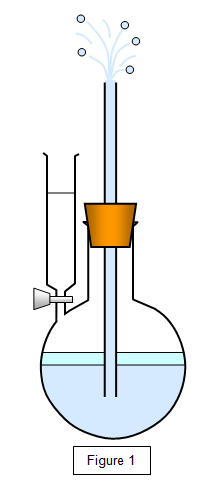
- Warming the flask gently.
- Increasing the area of the liquid surface.
- Blowing a stream of air across the surface.
- Reducing the pressure above the liquid surface.
Saturated vapours
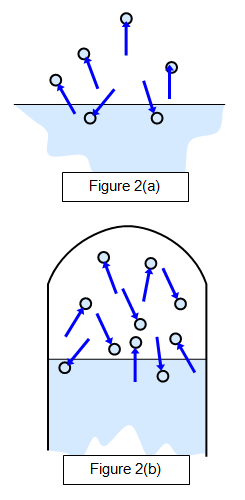
The Effect of Temperature on Saturated Vapour Pressure (S.V.P) of a Liquid
The Height, of mercury represents the saturated vapour pressure of the liquid in the flask. Saturated vapour pressure increases with the increase in Temperature (Ti) and the increased with decrease in Temperature (Td).
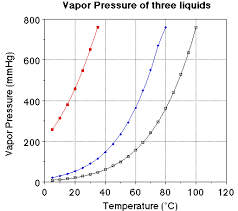
The graph of saturated vapour pressure (svp) against Temperature
The Concept of Humidity
Measurement of Relative Humidity
- Cotton manufacturing industries are constructed on sites where the relative Humidity (R.H) Is High.
- Cotton fibres must not become too dry, otherwise they become Brittle and hence cause difficulties in spinning.
- In contrast, a dry atmosphere is required by ware House for the storage of food, Tobacco and assembling of certain electrical components.
- Air – conditioning plants are installed in ships and buildings for the purpose of moderating Humidity.
MEASURING RELATIVE HUMIDITY
- Evaporation of water surrounding the wet bulb absorbs heat from the bulb, consequently the temperature of the wet bulb falls.
- The reading of the wet bulb thermometer is normally found to be several degrees below that of the dry bulb Thermometer is known as the wet bulb depression.
The less moisture the air has the greater the difference between the two thermometer reading.The difference is therefore greatest for dry air and zero for saturated air.
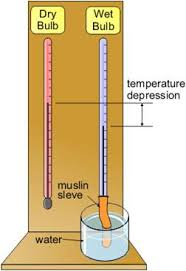
REGNAULT’S HYGROMETER: Is used to determine dew point and relative Humidity.Simplified form of regnault’s hygrometer consist of two test – tubes A and B with silvered ends C and D Respectively.
- Test tube A contains ether and it is fitted with rubber stopper which carries a thermometer T and two narrow tubes E and F.
- Test tube B. is empty and serves as comparison.
- Air is bubbled through ether via the narrow tube E by applying a fitted pump at the end of the Narrow tube F. This causes the rapid evaporation which results in the absorption of latent heat from ether and the container.
- Air surrounding the tube cools to temperature at which the water vapour present is sufficient to saturate it.
- Consequently is seen to form on C while D appears unchanged.
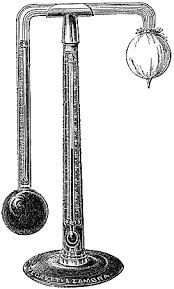
Above show Regnault (dew point ) hygrometer.
- The reading of the thermometer T is then noted.
- The flow of air through the ether is then stopped and the apparatus allowed warming up.
- The temperature at which the dew on C disappears is noted.
- The dew point is then taken as the mean of the two temperatures.
- Suppose the dew pint is Q1 and the actual air temperature is Q2 if the tables the value of S.V.P for water at Q1 and Q2 are X and Y millimeters of mercury Respectively.
- R.H = S.V. Pat Q1 x 100%/S.V.P at Q2
Example 2
The Knowledge of Humidity in Daily Life
- Consist of the tiny droplets of water or Ice floating in the sky formed by condensation of water vapor in the upper atmosphere.
- Clouds formation occurs when temperature falls below the dew point and small particles of dust or salt crystals are present to act as nuclei on which condensation can begin.
- Cooling is due to upward movement of air accompanied by example.
- Clouds may also formed when a warm moist air current meets a cold one if the drops become big enough by joining together they may fall as rain.
- Formed due to super cooling of water droplets in such a way that the droplets are cooling below 0oC without freezing.
- When these droplets are carried upwards by ascending air currents, they solidify upon coming into contact with ice crystals in the upper atmosphere.
- Hail stones are dangerous to air craft and human beings.
Smog: This is dense fog, where visibility is reducing to a few metres.







